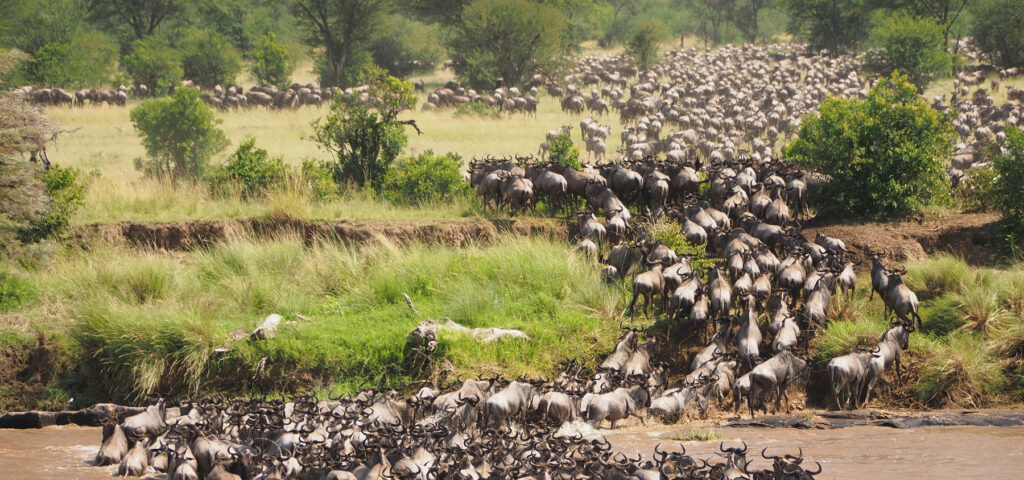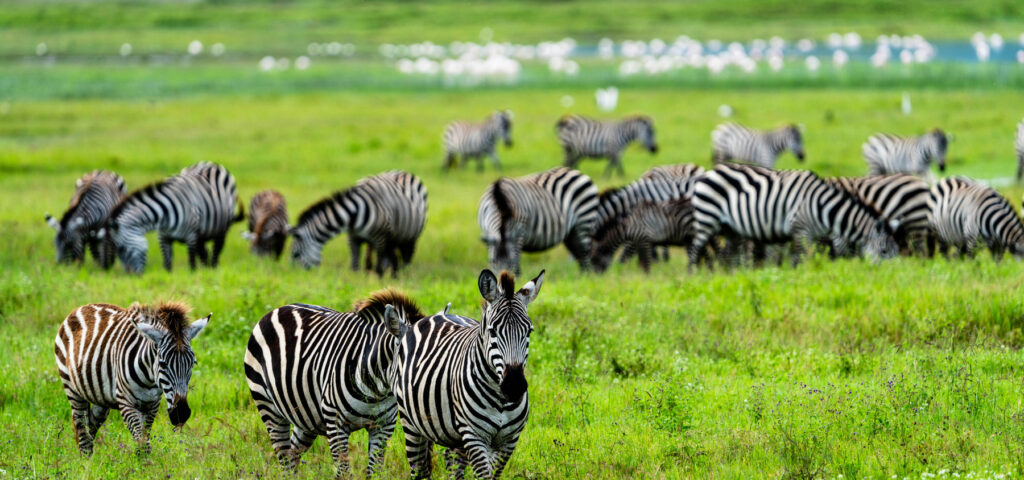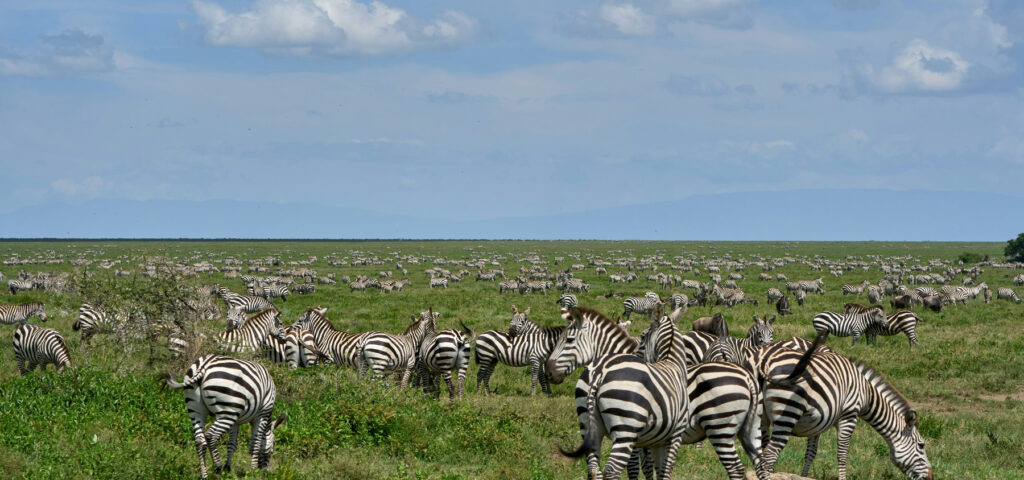The Great Wildebeest Migration in Tanzania is one of the most breathtaking natural spectacles on Earth.
Each year, over 1.5 million wildebeest, hundreds of thousands of zebras, and gazelles move across the Serengeti in a timeless rhythm of birth, survival, and renewal.
This endless circle of life is what defines the Serengeti ecosystem, and it’s one of the key reasons travelers come to Tanzania and Kenya. With Nandi Adventures, you don’t just watch the migration — you experience it in comfort, privacy, and style.
We design bespoke luxury safaris that follow the herds through the seasons, placing you in the perfect locations to witness nature’s greatest show — away from crowds, in the most exclusive camps, with guides who know every rhythm of the land.
Why the Great Migration Is So Extraordinary

The Great Migration is not a single event. It’s a year-round movement that follows Tanzania’s rainfall and grass growth. The journey spans 1,800 miles as wildebeest and zebras migrate in search of fresh grazing and water.
Along the way, they face lions, crocodiles, and the challenges of survival. Every month offers something unique — from the calving season in the south to the river crossings in the north.
Understanding when and where the herds are at different times of the year is the secret to planning the perfect migration safari. That’s where we come in. Nandi Adventures builds your itinerary around real-time migration data, local insights, and decades of guiding experience.
The Great Migration by Season
December to March — The Calving Season in Ndutu and the Southern Serengeti

This is the start of the migration cycle. After the short rains, the southern Serengeti and Ndutu region become green and lush — perfect for birthing.
Here, an estimated 500,000 calves are born within a few weeks, filling the plains with new life. Predators like lions and cheetahs are never far behind, creating dramatic wildlife encounters.
What happens: After the short rains, the plains around Ndutu in the Southern Serengeti erupt with life. Thousands of calves are born in quick succession, attracting predators and creating dramatic but accessible wildlife scenes.
Where to go: Ndutu, Seronera south, Southern Serengeti grasslands.
Why it works for families & older travellers:
- Guides tailor drives to suit slower paced mornings, and shorter drives for children or older companions.
- Plenty of time for rest, comfortable lodges with generous tents, en-suite bathrooms and private decks.
- Some migration camp move into the south during this time and includes family units.
Best for:
- Witnessing newborn calves and predator action
- Green landscapes and superb photography
- Families and travelers seeking immersive wildlife scenes
Nandi Adventures tip:
- Evening sundowners on the plains, and half-day drives mid-afternoon let you rest after breakfast and still catch the light.
- Combine with gorilla trekking and chimpanzee tracking in Uganda
April to June — The Journey North through Central and Western Serengeti

As the rains move north, so do the herds. The wildebeest and zebras begin their long trek across the central Serengeti toward the Western Corridor.
This is a lush, quieter time to travel. The plains are alive with green, and predator activity remains high. In May and June, the herds approach the Grumeti River, where the first water crossings take place — often in complete solitude.
What happens: The herds begin migrating out of the south toward central and western Serengeti as grass begins to thin in the calving zones.
Where to go: Central Serengeti (Seronera valley), Western Corridor (Grumeti).
Why it works for slower travellers:
- Fewer crowds compared to peak crossing season.
- Lush green landscapes from the late rains; soft light for photography and relaxed game drives.
- Mid-price luxury options and family-friendly camps with pools and spa facilities.
Best for:
- Travelers seeking fewer crowds and dramatic landscapes
- Early river crossings in June
- Photographers and nature lovers
Nandi Adventures tip:
- This is a wonderful “hidden season” — exceptional value, spectacular beauty, and peaceful lodges.
- Morning drive, midday pool time, late afternoon short drive — ideal for travellers who prefer not to rush.
July to October — The Iconic Mara River Crossings (Northern Serengeti & Masai Mara)

This is the most dramatic and famous phase of the Great Migration. In July, the herds reach the northern Serengeti, gathering along the banks of the Mara River. This is where instinct, danger, and courage collide — crocodile-filled waters, steep banks, and thousands of animals pushing forward in search of greener grass.
What happens: This is the iconic phase of the Great Migration. The herds edge northward, gathering at the Mara River where thousands attempt to cross crocodile-infested waters. Tension, motion and sometimes chaos become photographic gold.
Where to go: Northern Serengeti—Grumeti, Mara River, Kogatende.
Why it works for families and older guests:
- Choose luxury lodges perched near riverbanks with easy access (no rough tracks) and offer comfort, family rooms, and shorter transit times.
- Game drives scheduled to suit varying mobility levels; you can request shorter drives or comfortable lodge-based wildlife spotting from terraces.
- Balloon safaris available for older travellers who prefer a gentle but exhilarating experience.
Best for:
- Witnessing the legendary Mara River crossings
- Peak wildlife action — big cats, crocodiles, and elephants
- Hot-air balloon safaris and luxurious bush experiences
Nandi Adventures tip:
- Pack binoculars for river viewpoints
- Keep a flexible schedule—crossing timing is unpredictable, so longer stay at least 3-4 nights to increase your chances of seeing a crossing.
- Choose a private or conservancy-based camp for exclusivity.
November — The Return South
As the short rains return, the herds begin their long journey south. The grasslands revive, and the Serengeti becomes a lush expanse once again. This is a serene, atmospheric time to visit — with softer light, beautiful skies, and far fewer vehicles.

What happens: The herds begin returning south ahead of the next calving season. The Great Migration drama is less intense, but game is still excellent and crowds much thinner.
Where to go: Central Serengeti, corridors returning to Ndutu.
Why it works for families & older travellers:
- Peaceful game drives with early pickups and midday rest times.
- Lodges offer spa treatments, gentle walking safaris, and cultural visits (Maasai village visits suited for older travellers).
Best for:
- Travelers seeking tranquility and dramatic scenery
- Birdwatchers and photographers
- Return guests who want to see the cycle’s quieter side
- Families, honeymooners, wellness safaris, slow travel
Nandi Adventures tip:
- Combine the great migration with a gorilla trekking or chimpanzee tracking in Uganda or Rwanda for variety and extra value.
Month-by-Month Great Wildebeest Migration Map & Highlights
| Month | Region | Experience |
| January | Ndutu / Southern Serengeti | Peak calving season, predator encounters |
| February | Ndutu / Southern Serengeti | Newborn calves, family-friendly safaris |
| March | Central Serengeti | Start of movement north |
| April–May | Central & Western Serengeti | Lush scenery, fewer tourists |
| June | Western Corridor (Grumeti River) | Early crossings, excellent game viewing |
| July–August | Northern Serengeti | Peak Mara River crossings |
| September–October | Northern Serengeti / Mara | Continuing crossings, big cats |
| November | Central Serengeti | Return south, quiet safaris |
| December | Southern Serengeti / Ndutu | Green season, start of calving |
Photography & Wildlife Viewing Tips
- Be patient and flexible. Crossings don’t follow a schedule. Our guides read herd movement, wind, and behavior to position you at the right time. River crossings can take hours to build—your guide will read the signs.
- Use the golden hours. Early mornings and late afternoons give soft light and long shadows — ideal for professional photos.
- Fly-in safaris save time. Nandi Adventures arranges private charters to move between key regions so you follow the herds efficiently.
- Choose smaller camps. Boutique lodges and private-use vehicles guarantee a personal experience away from crowds.
- Gear: A zoom lens (200–600mm) captures both intimate and landscape shots.
Suggested Luxury Migration Itineraries
Tailor your great migration adventure by talking to safari experts to match your preferred travel dates, interests, and style. These itineraries are simply a window into what you can be able to do. You could take more days and spend more time enjoying the nature, and reviving your spirit. They can also have an add-on gorilla trekking safari in Rwanda or Uganda, or barefoot beach break in Zanzibar or Mombasa.
10-Day Calving & Southern Serengeti Safari (Dec–Feb)
Perfect for photographers and families. Includes Ndutu plains, predator-rich drives, and a conservation briefing with local rangers. Add on 4-day gorilla trekking safari
9-Day Classic Crossings Safari (Aug–Sep)
Fly between northern Serengeti and the Masai Mara to capture the most iconic moments of the migration. Add a hot-air balloon for sunrise drama.
12-Day “Follow the Herds” Fly-In Safari
Track the migration through Tanzania’s best lodges using private charter flights. Designed for photographers and luxury seekers who want to see it all — without backtracking. Top it up by flying from the Serengeti for a gorilla trekking safari in Uganda or Rwanda.
Responsible Travel & Conservation
The Great Migration is only possible because the protected areas in Tanzania and Kenya remain intact.
Nandi Adventures partners exclusively with camps and lodges that contribute to wildlife conservation, local employment, and community education. When you travel with us, your journey directly supports the preservation of the Serengeti and Maasai Mara, and its people.
We promote ethical wildlife viewing — no crowding, no off-road harassment, and respect for the natural rhythm of the animals.
Frequently Asked Questions (Migration FAQ)
When is the best time to see the Great Migration?
It depends on what you want to see:
- Calving & baby animals: January–March (Southern Serengeti)
- River crossings: July–September (Northern Serengeti)
- Quieter safaris: April–June or October–November
Can I guarantee seeing a river crossing?
No. Crossings are unpredictable, but our guides track real-time herd movement and weather to maximize your chances.
Is the Great Migration family-friendly?
Yes. Many luxury lodges offer child-friendly activities, family suites, and shorter game drives.
How long should I stay?
We recommend 8–10 days to allow for multiple regions and varied experiences. However, you can stay longer at your pace for a more intimate and slower travel – a wellness trip that is also good for your spirit. You can also add on a gorilla trekking safari in Uganda or Rwanda; or go barefoot on the pristine beaches of Zanzibar or Mombasa.



